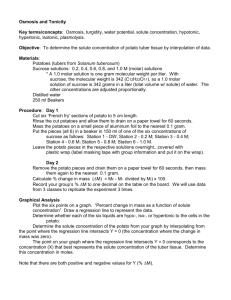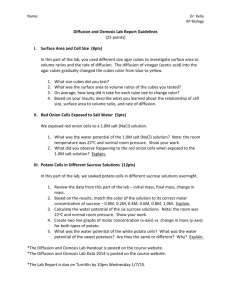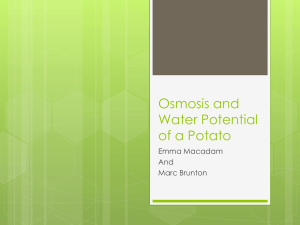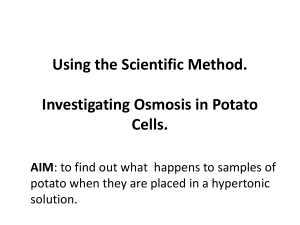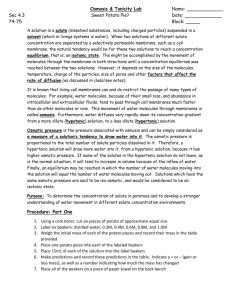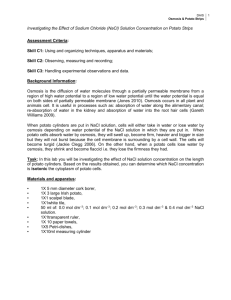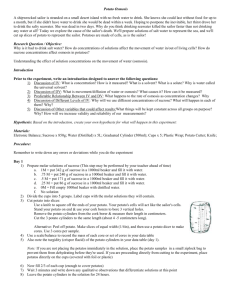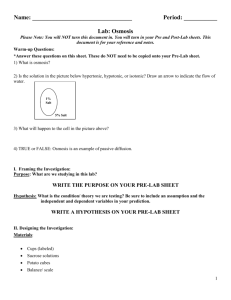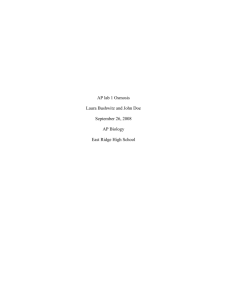Osmosis Lab
advertisement
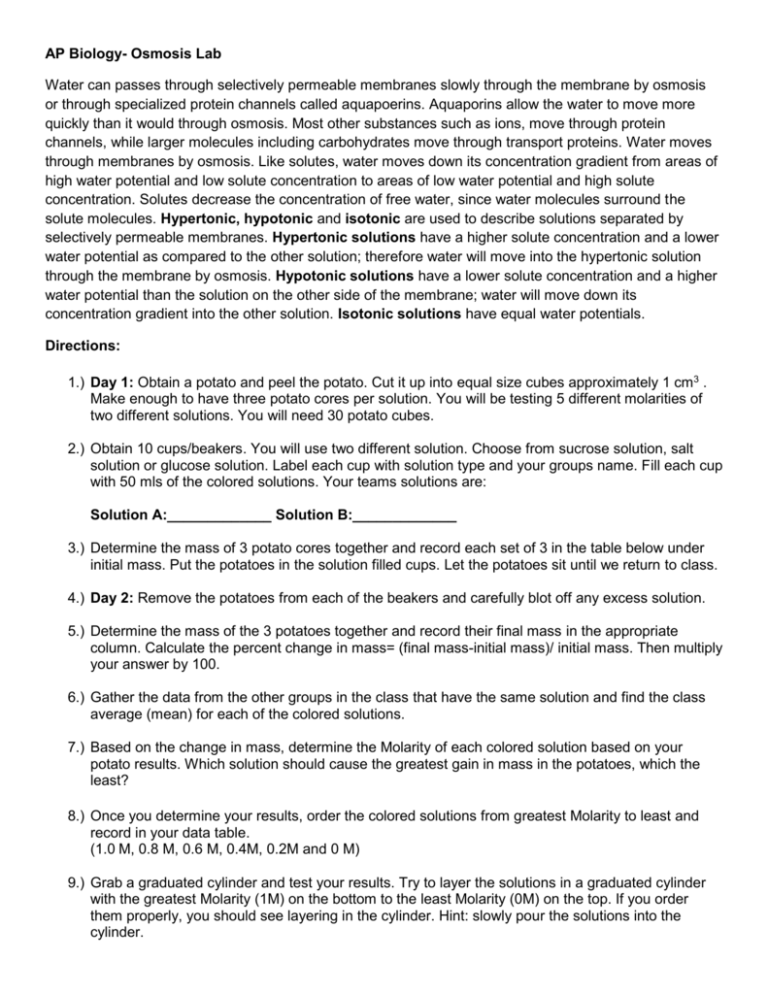
AP Biology- Osmosis Lab Water can passes through selectively permeable membranes slowly through the membrane by osmosis or through specialized protein channels called aquapoerins. Aquaporins allow the water to move more quickly than it would through osmosis. Most other substances such as ions, move through protein channels, while larger molecules including carbohydrates move through transport proteins. Water moves through membranes by osmosis. Like solutes, water moves down its concentration gradient from areas of high water potential and low solute concentration to areas of low water potential and high solute concentration. Solutes decrease the concentration of free water, since water molecules surround the solute molecules. Hypertonic, hypotonic and isotonic are used to describe solutions separated by selectively permeable membranes. Hypertonic solutions have a higher solute concentration and a lower water potential as compared to the other solution; therefore water will move into the hypertonic solution through the membrane by osmosis. Hypotonic solutions have a lower solute concentration and a higher water potential than the solution on the other side of the membrane; water will move down its concentration gradient into the other solution. Isotonic solutions have equal water potentials. Directions: 1.) Day 1: Obtain a potato and peel the potato. Cut it up into equal size cubes approximately 1 cm3 . Make enough to have three potato cores per solution. You will be testing 5 different molarities of two different solutions. You will need 30 potato cubes. 2.) Obtain 10 cups/beakers. You will use two different solution. Choose from sucrose solution, salt solution or glucose solution. Label each cup with solution type and your groups name. Fill each cup with 50 mls of the colored solutions. Your teams solutions are: Solution A:_____________ Solution B:_____________ 3.) Determine the mass of 3 potato cores together and record each set of 3 in the table below under initial mass. Put the potatoes in the solution filled cups. Let the potatoes sit until we return to class. 4.) Day 2: Remove the potatoes from each of the beakers and carefully blot off any excess solution. 5.) Determine the mass of the 3 potatoes together and record their final mass in the appropriate column. Calculate the percent change in mass= (final mass-initial mass)/ initial mass. Then multiply your answer by 100. 6.) Gather the data from the other groups in the class that have the same solution and find the class average (mean) for each of the colored solutions. 7.) Based on the change in mass, determine the Molarity of each colored solution based on your potato results. Which solution should cause the greatest gain in mass in the potatoes, which the least? 8.) Once you determine your results, order the colored solutions from greatest Molarity to least and record in your data table. (1.0 M, 0.8 M, 0.6 M, 0.4M, 0.2M and 0 M) 9.) Grab a graduated cylinder and test your results. Try to layer the solutions in a graduated cylinder with the greatest Molarity (1M) on the bottom to the least Molarity (0M) on the top. If you order them properly, you should see layering in the cylinder. Hint: slowly pour the solutions into the cylinder. Solution A :______________________ Solution Molarity % Change Initial Mass Final Mass Mass Difference A in Mass Class Mean Class SD Blue Yellow Red Green Clear Solution B:_____________________________ Solution Molarity % Change Initial Mass Final Mass Mass Difference A in Mass Blue Yellow Red Green Clear Class Mean Class SD 10.) Graph the results for both your individual data and class average on a graph. In order to do so, the 0 axis line should actually be in the middle of your graph. The y axis above this line should be labeled % increase in mass while the y axis below this line should be labeled % decrease. The x axis is the sucrose Molarity within the beaker. 11.) Determine the molar concentration (osmolarity) of the potato cores. This would be the sucrose, glucose or salt molarity in which the mass of the potato core does not change. To find this, draw the straight line on your graph that best fits your data. The point at which this line crosses the x axis represents the molar concentration of sucrose, glucose or salt with a water potential that is equal to the potato tissue water potential. At this concentration, there is no net gain or loss of water from the tissue. Your determination of the molar concentration (osmolarity) of your potato as it relates to your solution. This is where the mass of the potato cores would not change – use your regression analysis for this calculation. Use the formula for the straight line that best fits your data. The point at which this line crosses the X-axis represents the molar concentration of sucrose, glucose or salt with a water potential equal to the potato tissue water potential—therefore, it will be where there is a 0% change. Be sure to include this very important calculation y=mx + b 12.) From the graph determine the Molar concentration of the potato? ___________ Solution A:_____________________________ Solution B:_____________________________ Osmosis Lab Part II Submit your write up to me by Friday via google docs. Introduction: Write a brief introduction about osmosis in living cells. Data 1.) Insert your data into in Excel. Use Molar Concentration and Mean % change. Plot each set of data using a scatter plot. Then use the chart tools/ layout to insert the trend line (linear regression line) and the equation of the line. Label the graph and include your axis titles. 2.) Plot both sets of data. 3.) Determine the Molar concentration of the potato for the two solutions. Post lab Questions: 1.) Based on your data, was the molar concentration of the potato in each solution the same? In other words at what point does the net movement of water equal zero? Explain. 2.) What factors determine the rate and direction of osmosis? 3.) Based on your data, can you predict the direction of osmosis in living cells when the cells are placed in various solutions? Explain. 4.) Describe the difference between water potential and solute potential. Include an error analysis section and a conclusion.
